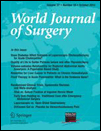Identification of Hepatoma-Derived Growth Factor as a Potential Prognostic and Diagnostic Marker for Extrahepatic Cholangiocarcinoma
Abstract
Background
Hepatoma-derived growth factor (HDGF) has been reported to play a pivotal role in the development and progression of several tumors. The aim of the present study was to analyze whether HDGF is a potential prognostic and diagnostic marker for extrahepatic cholangiocarcinoma (EHCC).
Methods
The immunostaining of HDGF was analyzed by immunohistochemistry for 65 pathologically confirmed EHCC, and its correlation with clinicopathologic factors and prognosis was investigated. Meanwhile, to evaluate the diagnostic value of HDGF, an enzyme-linked immunosorbent assay (ELISA) was performed to measure HDGF levels in the serum samples of 83 EHCC patients and 51 healthy controls.
Results
Positive expression of HDGF was detected in 30 (46.2 %) patients with EHCC and correlated with poor tumor differentiation (P = 0.024). Univariate analysis showed that the positive HDGF expression group had a significantly poorer survival rate than the negative HDGF expression group did (P < 0.001). Multivariate analysis demonstrated that HDGF expression and N stage were independent prognostic factors. The mean serum HDGF level in EHCC patients was 2.39-fold higher than that in healthy controls (P = 0.002). The optimal cut-off value for HDGF was 122.15 pg/mL, providing a sensitivity of 66.27 % and a specificity of 88.24 %. The area under the curve (AUC) of HDGF was 0.807 (95 % confidence interval 0.730–0.870), demonstrating that HDGF was a potential biomarker for EHCC.
Conclusions
HDGF was a valuable independent prognostic factor after curative resection in EHCC, and it provided an important basis for screening/treating high-risk patients. Meanwhile, our study indicated that serum HDGF levels can be used as a noninvasive and potential diagnostic marker for EHCC.




